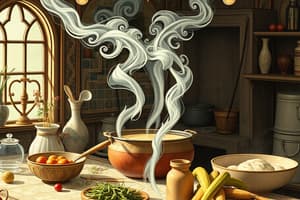Podcast
Questions and Answers
What is the primary reason for using gentle heating when preparing soup?
What is the primary reason for using gentle heating when preparing soup?
- To prevent the soup from boiling over.
- To save energy and cooking time.
- To avoid scorching the soup.
- To allow flavors and textures to develop fully. (correct)
Why is it important to season soup before adding dairy products?
Why is it important to season soup before adding dairy products?
- To prevent the dairy products from curdling. (correct)
- To ensure that the flavors of the dairy products are fully incorporated.
- To allow the seasonings to permeate the soup more effectively.
- To enhance the natural sweetness of the dairy products.
What is the main function of a stock in the context of menu items?
What is the main function of a stock in the context of menu items?
- To create a visual contrast in a dish.
- To add a specific flavor profile to a dish.
- To provide a base for soups and sauces. (correct)
- To thicken a sauce or soup.
What is the significance of a soup's serving temperature?
What is the significance of a soup's serving temperature?
Why is it important to consider the overall menu when preparing stocks, sauces, and soups?
Why is it important to consider the overall menu when preparing stocks, sauces, and soups?
Which of these ingredients is NOT typically used in the preparation of a traditional vegetable stock?
Which of these ingredients is NOT typically used in the preparation of a traditional vegetable stock?
Why is it important to skim impurities from a simmering stock during preparation?
Why is it important to skim impurities from a simmering stock during preparation?
What is the key difference between a velouté sauce and a béchamel sauce?
What is the key difference between a velouté sauce and a béchamel sauce?
Why is it important to allow a sauce to rest after preparation?
Why is it important to allow a sauce to rest after preparation?
What is the primary difference between a clear soup and a cream soup?
What is the primary difference between a clear soup and a cream soup?
What is the most important factor to consider when choosing ingredients for a stock?
What is the most important factor to consider when choosing ingredients for a stock?
Which of the following is NOT a key step in sauce preparation?
Which of the following is NOT a key step in sauce preparation?
When preparing a soup, what is the purpose of pureeing some of the ingredients?
When preparing a soup, what is the purpose of pureeing some of the ingredients?
Flashcards
Chopping vegetables
Chopping vegetables
Cutting vegetables into precise, even pieces for soup.
Gentle heating
Gentle heating
Slowly heating ingredients to develop textures and flavors.
Incorporating ingredients
Incorporating ingredients
Add ingredients carefully to avoid lumps and inconsistency.
Correct seasoning
Correct seasoning
Signup and view all the flashcards
Role of stocks
Role of stocks
Signup and view all the flashcards
Stock
Stock
Signup and view all the flashcards
Types of Stock
Types of Stock
Signup and view all the flashcards
Chicken Stock
Chicken Stock
Signup and view all the flashcards
Proper Simmering
Proper Simmering
Signup and view all the flashcards
Sauce
Sauce
Signup and view all the flashcards
Béchamel Sauce
Béchamel Sauce
Signup and view all the flashcards
Clear Soup
Clear Soup
Signup and view all the flashcards
Cream Soup
Cream Soup
Signup and view all the flashcards
Study Notes
Stock Preparation
- Stocks are fundamental to sauces, soups, and numerous dishes. They provide depth, flavour, and body.
- Stock creation involves simmering bones, meat trimmings, vegetables, and herbs in water.
- Stock types include:
- Chicken stock: Made from chicken bones and/or meat.
- Beef stock: Made from beef bones and/or meat.
- Fish stock: Made from fish bones or trimmings.
- Vegetable stock: Made from vegetable scraps or pureed vegetables.
- Proper stock preparation involves:
- Choosing suitable ingredients: Bone quality directly affects stock flavour.
- Sufficient water: Water should fully cover ingredients; avoid excessive water, which can dilute the stock.
- Gentle simmering: Avoid boiling, which may lead to a cloudy stock. A slow simmer ensures better flavour development.
- Skimming impurities: Regular skimming removes impurities, resulting in a clearer stock.
- Subtle seasoning: Seasoning should be subtle; intense seasoning can overpower the other elements.
- Cooling and storage: Allow the stock to cool, store in the refrigerator, and freezing is also suitable for later use.
Sauce Preparation
- Sauces enhance flavour and texture in dishes.
- Sauce techniques vary by type:
- Béchamel (white sauce): Composed of milk and butter, often thickened with flour.
- Velouté (smooth sauce): Made from stock and thickened with pureed vegetables.
- Tomato sauce: Created by simmering tomatoes, often with herbs and spices.
- Brown sauce: Derived from stock and flavourings, often incorporating browned meat or vegetables.
- Sauce preparation steps include:
- Precise measurements: Accurate measurements maintain the balance and consistency of the sauce.
- Correct thickening methods: Smooth thickening prevents lumps and maintains desired texture.
- Blending ingredients: Blending ensures proper consistency and desired texture.
- Appropriate seasoning: Seasoning should be adjusted to the specific dish. Over-seasoning can be difficult to correct.
- Allowing sauces to rest: This allows flavours to meld and deepen.
Soup Preparation
- Soups are nourishing and versatile food items.
- Soup types include:
- Clear soups (broths): Made from stock with additions of vegetables, herbs, or meat.
- Cream soups: Made from stock, cream, and pureed vegetables or other ingredients.
- Vegetable soups: Comprised of various vegetables, herbs, and spices.
- Soup preparation involves:
- Precise vegetable chopping: Consistent cuts improve appearance and even flavour distribution.
- Gentle heating: Gentle heating allows ingredients to develop flavour and texture.
- Carefully incorporating additional ingredients: Avoid lumps and ensure consistent flavour profiles.
- Correct seasonings and additions: Season before adding other ingredients (like dairy) to avoid altering flavour balances.
- Thorough heating: Full heating eliminates raw ingredients.
- Serving at appropriate temperature: The right serving temperature enhances the soup-eating experience.
Menu Item Connection
- Stock, sauce, and soup preparation relate directly to menu elements.
- Stocks serve as bases for sauces and soups.
- Sauces add richness and flavour to various dishes.
- Soups serve as separate courses or side dishes. The whole menu should be considered, and the connection between stock, sauce and soup components should be understood to ensure a cohesive dish.
- Understanding the distinct roles – stock, sauce, and soup – provides a fundamental approach to preparing each item on a menu.
Studying That Suits You
Use AI to generate personalized quizzes and flashcards to suit your learning preferences.




